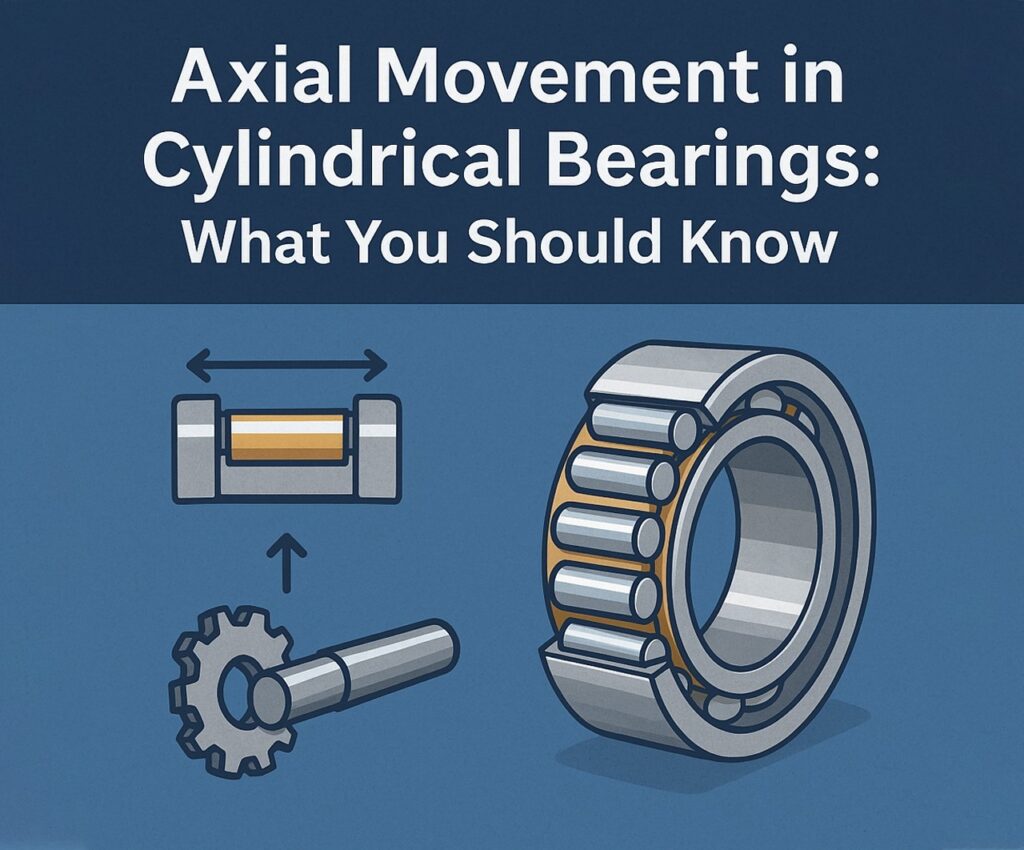When it comes to high-performance mechanical systems, managing axial movement is often just as critical as handling radial loads. That’s where the design and structure of a cylindrical bearing, also referred to as a bearing cylindrical, come into play—especially in systems requiring both axial and radial load control. In many industrial applications, axial radial cylindrical roller bearings are the unsung heroes, quietly keeping precision components aligned, stable, and efficient even under extreme stress.
Understanding how axial movement affects performance—and how cylindrical bearings are designed to manage it—can give engineers and designers the edge they need in selecting the right components for their machinery. Know More
What Is Axial Movement in Bearings?
Axial movement refers to the displacement of a bearing along the axis of a rotating shaft. In simpler terms, it’s how much a bearing can “slide” or shift lengthwise without affecting its rotational function.
While most bearing types focus on radial loads (forces perpendicular to the shaft), axial movement becomes critical in applications with shifting or thermal expansion. The ability of a cylindrical bearing to accommodate this kind of motion can significantly extend the lifespan of both the bearing and the equipment it supports.
Anatomy of a Cylindrical Bearing
A bearing cylindrical uses rollers instead of balls to distribute load across a larger surface area. These cylindrical rollers are typically guided in a cage, and the races are designed to allow high radial load capacity.
Here’s where things get interesting: Some versions of axial radial cylindrical roller bearings have special inner or outer rings that float axially, specifically to accommodate axial displacement. This feature makes them ideal for thermal expansion scenarios or shafts with longer unsupported lengths.
Why Axial Movement Matters
Ignoring axial movement can lead to:
- Increased friction and heat
- Premature wear or failure
- Noise and vibration issues
- Misalignment damage
In contrast, selecting the right cylindrical bearing that accounts for axial forces can prevent mechanical disasters and optimize long-term performance.
How Cylindrical Bearings Handle Axial Loads
Although bearing cylindrical types are primarily designed for radial loads, certain variants are engineered to manage limited axial loads too. These bearings often feature modified rib designs or open-ended configurations that allow one ring (usually the inner or outer) to “float” or shift slightly in the axial direction.
Types of Axial Movement Management:
- Free-floating designs: Allow axial movement within the housing or shaft to compensate for thermal expansion.
- Fixed/floating arrangements: One end of the shaft is held rigidly while the other end is allowed axial freedom using floating bearings.
- Adjustable clearance: Some axial radial cylindrical roller bearings are built with adjustable axial clearance to fine-tune movement tolerance.
Applications Where Axial Movement Is Critical
1. Electric Motors and Generators
High-speed shafts in motors often experience thermal elongation. Using a cylindrical bearing with axial movement capability ensures components remain aligned despite temperature shifts.
2. Pumps and Compressors
In these systems, thermal gradients and internal pressure cause both shaft expansion and axial displacement. Axial radial cylindrical roller bearings absorb both forces while maintaining rotational efficiency.
3. Steel Mills and Paper Machinery
Heavy-duty rollers face frequent directional changes and heat. A bearing cylindrical setup designed for both axial and radial stress is essential to avoid breakdowns.
4. Railway and Transportation
Cylindrical roller bearings in axles and gearboxes often need to manage combined forces while staying within tight axial movement tolerances.
Common Configurations for Axial Management
NU Type Bearings
- Inner ring with two flanges, outer ring with none
- Allows axial movement of the shaft relative to the housing
- Perfect for free-end support in a fixed/floating bearing setup
N Type Bearings
- Outer ring has flanges, inner ring does not
- Functions similarly to NU type but in reverse configuration
NJ and NUP Types
- Include flanges that allow limited axial movement
- Suitable for semi-fixed positions where axial movement is controlled, not free
These types of axial radial cylindrical roller bearings give engineers the flexibility to support or float a shaft based on operational needs.
Axial Movement vs. Misalignment: Not the Same Thing
It’s easy to confuse axial movement with shaft misalignment, but they’re fundamentally different:
- Axial movement is intentional and necessary in certain designs.
- Misalignment is usually a defect that causes uneven load distribution.
Cylindrical bearings are not built to handle misalignment well. That job is better suited for spherical or self-aligning bearings. Use cylindrical bearing solutions only when the shaft and housing are well aligned and axial control is required.
Design Considerations for Engineers
When selecting or designing with a bearing cylindrical, you need to ask:
- Will the shaft expand axially under load or temperature?
- Do I need one end of the shaft to “float”?
- What’s the expected axial load vs. radial load?
- Is thermal expansion predictable and manageable?
- Can I use fixed/floating bearing placement to reduce stress?
Answering these questions ensures you select the right axial radial cylindrical roller bearings that won’t seize, bind, or wear out prematurely.
Installation Tips: Don’t Overlook the Details
Proper installation is as critical as design:
- Preload carefully: Over-tightening destroys the bearing’s ability to move axially.
- Align perfectly: Remember, bearing cylindrical types don’t forgive misalignment.
- Use correct housing tolerances: Allow enough space for axial float without causing instability.
Future Trends in Cylindrical Bearing Design
The evolution of cylindrical bearing technology is moving toward:
- Integrated sensor bearings to track axial load, temperature, and wear in real-time
- Lubrication-retaining designs that reduce the need for frequent greasing
- Lightweight alloys for mobile or weight-sensitive applications
With the push for more efficient and intelligent mechanical systems, modern axial radial cylindrical roller bearings will soon play a role in data collection, diagnostics, and predictive maintenance.
Conclusion
Axial movement isn’t just a design detail—it’s a critical performance factor in rotating machinery. Choosing the right cylindrical bearing setup can mean the difference between long-term stability and early failure. Whether you’re dealing with high-speed motors, heavy industrial rollers, or compact automation components, understanding how bearing cylindrical types manage axial displacement gives you the control needed to build smarter, stronger machines.
When selected and applied correctly, axial radial cylindrical roller bearings offer a robust solution to handle both directional forces while keeping everything running smoothly.

